
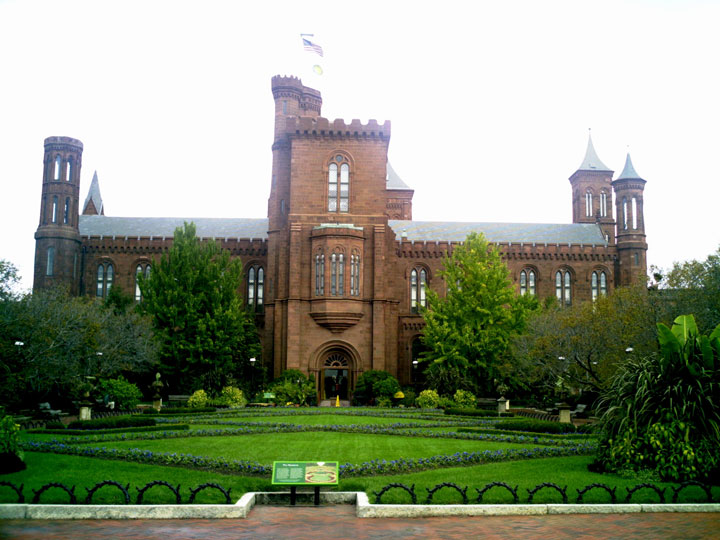
The Smithsonian Institution. All photos provided by Orin Humphries.
© By Orin Humphries
October 2012
All my life I dreamed of being able to go to the National Archives and Record Administration, NARA, and the Smithsonian's National Air and Space Museum, NASM, to get the scale documentation and drawings I wanted for various scale projects. I tried writing to them over the decades, but never really got just what I needed. The people working there are good people, but they are not scale modelers and can't tell by looking at a drawing or a photo if it is what will help the requester. When I recently requested a drawing of the F-82 with cross-sections, the head of the Archives at Boeing History sent me an inboard profile. Yes it is a “cross-section” but it is the wrong cut direction. When I asked NARA for photos of the P4M Mercator, they sent photos of the wooden mockup, the XP4M. There were significant changes from mockup to the production version.
As a teacher for the first 20 years I could never afford to make a trip in person to Washington, D.C. to put eyes on the materials for proper selection. It was after working for Boeing for 18 years after a career change to Aeronautical Engineer that I could afford the voyage of a scaler's lifetime.
You have to set up an appointment with both NARA and NASM for your visits, so I wrote the letters. I got back a letter from NARA saying that they now required the visitors to have letters of permission from the aircraft factories before NARA could release copies of drawings. I duly wrote five manufacturers requesting such permission. I received ... silence, from four of them. Could I be the first to be refused? What did the silence mean? One, Northrop Grumman, said they would not grant access to F8F Bearcat drawings for liability reasons. I surmised that there had been at least the threat of lawsuits from RC modelers who had crashed their airplanes into buildings and so forth. In this litigious (from “litigation”) country of ours, the lawyers put everyone conceivable into a lawsuit, including the manufacturer of the wheels, fuel tank, enabling drawings, etc. NARA told me that without such letters I would be limited to viewing microfilm of the drawings and making handwritten notes. There would be no screenprints.
This was literally maddening for a scale modeler who, like all the others, had had free access to three-views all their lives! The drawings had been in many magazines, so just where was access effectively restricted in order to save the factories from lawsuits? We have been circulating scale information for a century! To this layman, the materials were public domain. That is the way it is in the area of patents. Once the inventor published an invention before the patent was granted, the ideas are deemed “public domain” and cannot be protected. I know nothing at all about copyrights for sure, though.
At the NASM, by then, I was told that they had received bushels of permission letters over the previous decade or so (it was the NASM that started this and NARA had gotten in line thanks to their lawyers, the National General Counsel's office). By the time of my proposed visit to the NASM, October 2009, the NASM was no longer requesting permission letters from visitors. For one airplane which shall remain unnamed, NARA refused copies of drawings, but, the curator of the National Museum of the Marine Corps told me that the NASM had a set of microfilm reels of the subject aircraft. The archivist at the NASM assured me that they would have copies of the 12 reels made and sell them to me at cost, $30 apiece.
I have currently under way is a series of ordered drawings at the NASM Archive. You must plan WAY ahead for these. The subject is my F-84 project. If you tell them you want Paul to process the drawings, you have to get in line. When your turn comes it takes a couple weeks for him to do that, creating digital files with their own numbers. He sends you a list of drawing number, contents, file number, and cost. You go on line to NASM Archive and print out order sheets. Your ordering prints is limited to a hard and fast rule of 10 drawings per order so all the requestors get equal access. When one completed order is in your hands you may mail in the next one. I want 45 drawings, so that constitutes five separate orders. Each one takes a month to mail in and receive it. Thus, my orders will take five months to complete. The first one is in my hands and finished with and I expect the second's arrival any day. I could buy a clunker for the cost of 45 processed drawings.
NASM prints carry a red ink stamp that disclaims responsibility for damage resulting, etc., and says these cannot be passed on our used for commercial projects.
A year and a half into retirement Jan and I headed for WADC for two weeks research and vacation. Around my time in the archives, we would visit several Smithsonian museums, Williamsburg, Jamestown, Boston Harbor, Philadelphia, Kitty Hawk, and The Outer Banks. At Boston Harbor in 1812 Francis Scott Key penned the words to the immortal anthem, “Yellow Submarine” ... He did. (Naw, can't help it.)

Orin at Kitty Hawk.
At Williamsburg, a formal park, there are many people in costumes of the colonial times. They are there to answer questions about the history and the life in those times, making it a wonderful vacation stop.
In one of the museums they have the flag that flew over Fort McHenry. It was made by Betsy Ross as you know and it was sized “so as to be visible to the British at five miles.” It is HUGE. However, it is now almost square thanks to vandalism by souvenir hunters before it came into the national collection. They took about a square foot from it apiece. It has aged and the fabric is on the verge of not being able to support its own weight, now. Plans are being made to take care of that.
At the NARA on my last day, I spent time looking at 8x10 b&w photos of Navy aircraft for later placing of orders. All of the photos are stamped, “Official USN Photo”. You can have copies made of those without permission letters as they were paid for with taxpayer money by service people, government employees, so to speak. The cost is prohibitive, though, about $8.50 apiece. They will let you make your own copy negatives or digital files. They even have copy boards with lights for your use. I plan to take along a scanner on our return as soon as my F-84 is off my building table. I will make digital copies of all the WW II airplanes my collecting hobby missed. My own archive fills a medium-sized bedroom, having begun in 1950 or so.
The archivist at the NASM, Dave Schwartz, had the files all researched and the corresponding microfilm reels ready for my viewing. The reels are in cold storage and require two days to come back to room temperature for viewing. The lens on each film scanner/viewer is a cheap grind and the images suffer from “spherical aberration.” That means they are slightly “fish-eyed.” You can't tell that looking at them on the screen, though. They only let a few customers in the viewing room at a time so each can have access to printers and elbow room. Appointments are mandatory.
You can write the archive and request that the images be processed for drawings whose numbers you list. Paul Silberman there takes the several screen views that are needed to cover a given drawing and scans them in to digital format. These files are then “stitched together” using the application, Photoshop. He then hits the “remove spherical aberration” button, and that goes quite a ways toward making the file “rectilinear.” Such drawings are quite spendy, but worth it to really serious types.
This process was not perfect with the software they had at the time. I ordered a drawing of the drop tank for my F2G project. When I checked the scaling between station lines on the processed drawing, I found that it varied from one section to another. I corrected that by vertically slicing the drawing along station lines and taping the pieces to a backing at the proper distance from the nose of the tank. Since then, they have obtained better software. I recently got another processed drawing and found it to be vastly improved in dimensional fidelity.
All our lives we idealized microfilmed drawings as a perfect medium for preserving and reproducing drawings for scale models. Read on.
The problems are many. These exposures were made 50 or more years ago and the film is deteriorating. There is now a program to re-scan the originals and make digital files. That will take decades. So far, digital media are not deemed “archival quality” due to various ways the files can be lost or corrupted. As the present film media age, they shrink non-uniformly. That is to say, the celluloid backing does not shrink, but the gelatin-based emulsion does differentially. The emulsion carries the image and the lines move around a bit. It is drying out.
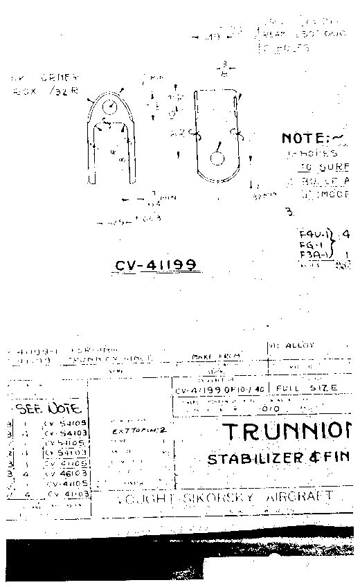 Another problem with the microfilm is that the exposures were not all correct. It turned out that in my set of 12 reels for the F2G, every time I came to a most critical drawing for the project, the exposure was all but unusable. I had to find workarounds for that part of the structure from other drawings. There is one drawing of the fuselage cross-sections for the F2G aft of the cockpit, the turtle deck that defines the Super Corsair. The drawing looks like snow on a TV screen for the most part. The Archive at NASM could not change settings enough to make the noise diminish and the lines come out.
Another problem with the microfilm is that the exposures were not all correct. It turned out that in my set of 12 reels for the F2G, every time I came to a most critical drawing for the project, the exposure was all but unusable. I had to find workarounds for that part of the structure from other drawings. There is one drawing of the fuselage cross-sections for the F2G aft of the cockpit, the turtle deck that defines the Super Corsair. The drawing looks like snow on a TV screen for the most part. The Archive at NASM could not change settings enough to make the noise diminish and the lines come out.
At right, a poor-quality microfilm image of the Vaught stabilizer mentioned near the end of the article.
I was able to restore 90% of the drawing by using a few lines that appeared in part and noting one thing about the “snow dots.” Where a (presently invisible) drawing line crossed an also invisible grid line, the dot was darker. Using the neighboring line segment as a guide, I connected the darker dots parallel to the existing line segment. Then I did the same for the dots next to my new line, and so on. I have to lay eyes on the original drawing to finish the restoration on our next trip to the NARA after my F-84 is off my table.
Still another problem with the microfilm is the setup of the original camera. It should always be centered over the exact middle of the drawing and perpendicular to the drawing. The drawings came in at least four different sizes, and so the technician would have to change the equipment around endlessly. Pity these poor souls exposing the film! They had to make tens of thousands of negatives day in and day out. Their morale and consequently the quality of their work varied after a while. Could any of us have done better for that long? The assembly drawing for my F2G's horizontal stabilizer was very strange. If I sized it for the correct span at my model's size, the chord-wise size was off by a good 20%, longer. If I sized the print for the correct chord dimensions, the length was undersized too much to be usable. I got around this partly by using other dimensional information for the outline lofting. I sized the drawing for the chord size and marked on my outline the locations of the stringer terminations. I had to slide the print to get the ends at the proper places on the plan view of the stabilizer. I then connected the ends of the stringers with a straight edge. I recently ran into the same distortion in a drawing of wing rib pieces for my F-84.
I have thought long and hard as to how these weird distortions could have been made. The best I can come up with is that the camera was not centered over the long drawing, along the long axis of the drawing. The camera could have then been tilted to point toward the center of the drawing. This would produce different scales in the x- and y-axes.
Most drawings of airplane parts are not dimensioned so that the modeler can directly size them for tracing or simply erecting the part at model size. Dimensioning is actually rare in these collections. My efforts to get the first accurate fuselage cross-sections for the F-82A and -B were thwarted by the drawings for the four pieces comprising each fuselage frame having only the dimensions from the “part locating holes” in the assembly jigs listed as to how far the vertical and horizontal reference lines were away. There are no dimensions that tell you how far from the jig hole to the outer edge of the part. It crossed my mind recently that if I were to live long enough I could get 1:1 drawings of the frame pieces and paste them up on a backing at the proper distance to the reference lines. Never happen.
Sadly, no service collected the mold line drawings from a manufacturer. The lines we need most are lost to History, sequestered in old storage facilities and there is no budget anywhere for their retrieval even if you volunteer your time and money for access. You see, the services needed only those drawings for the maintaining of the equipment. Mold line drawings served no need at all in their worlds. The burden of maintaining archives of the useful drawings was enormous, so why make matters worse with storing unused materials?
Besides a set of part and assembly drawings, two different kinds of indexes for the drawings were part of the cost. One kind of index is an alphanumeric version of the drawing numbers. The other kind is an alpha list of the drawings' nomenclature. In one case, the B-36, Convair requested that they be excused from providing one type of index as a cost saving measure. That was granted.
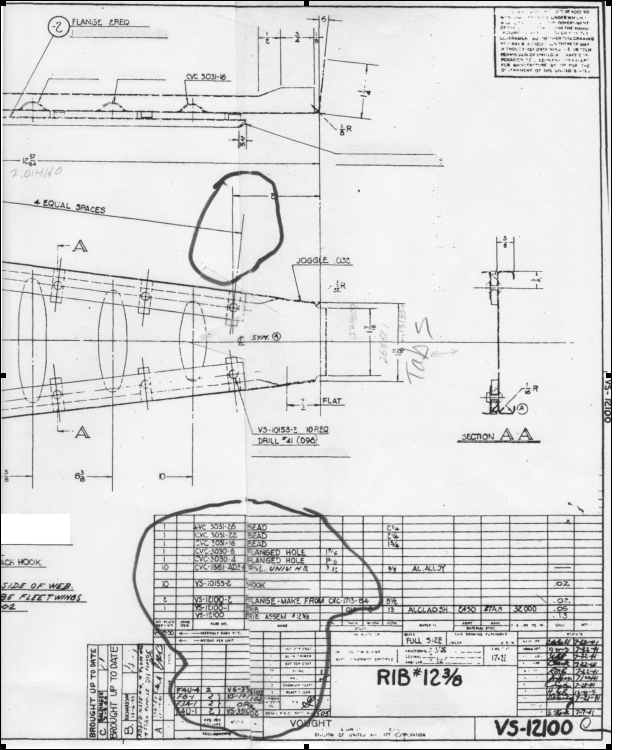
Lines on a microfilm photo of a fuselage are mismatched.
The microfilm scanner at the local public library has a cheaper lens, and all of the wing part drawings I scanned for my F2G are fish-eyed. The pile of drawings is one inch thick and some must be re-done after my F-84 is flying. I was forced to bite the bullet and buy my own microfilm scanner with a good lens. I got a used one with such a lens for the cost of a used car! The company that sold me the scanner also gave me an old computer and software to make the digital files and the prints from those. The company had contacted the scanner maker to confirm that the lens was a good one. See the picture with two areas looped with felt marker. In the smaller loop, the lines from each side of printouts that are taped together within the loops are matched up well. Down at the bottom of the drawing, though, the larger loop shows notable mismatches of lines in the drawing's nameplate. This is from spherical aberration, or fisheye from the scanner's cheaper lens.
You need to know that each branch of the military has a clause in the contract for the equipment purchased by the government that states a complete set of factory drawings is to be delivered with the production lot. The curator of the Martin Museum told me that. So then, the taxpayers own the copies of these drawings stored at the NARA and the NASM. I hold that they are public domain, but I am not a lawyer.
Over the past two years, though some light has appeared on the horizon. I bought a copy of Boone Guyton's autobiography. He was the project pilot for the Vought F4U Corsair. He stated that during WW II the government ordered and paid for a circulating of the 13 types of combat aircraft that the government was purchasing around to each of the manufacturers. They were ordered to check out each other's designs and incorporate the best features into their own designs. That way America would be fielding the most effective combat equipment and shorten the war. Boone's reference is thin in detail, though I knew of a few other specifics from my lifelong study of aviation history. The same sort of thing had happened in WW I between the Wright and Curtiss factories. In their memoir, the Wrights tell of the government ordering them to form a single, combined corporation and to abandon their legal patent battles. The Wrights were incensed by having their name second to Curtiss' whom they labeled a patent thief.
I stumbled onto an account of the WW II technology exchange written by Corky Meyer, a project pilot and later on a vice president for Grumman. It took me maybe nine months to obtain an original copy of Boone's autobiography through Amazon.com. In this gem, Corky relates specifically 24 instances of technology interchange that continued past the Korean War and took place on the level of test pilot to test pilot, company to company, and all possible combinations thereof. I put each such reference into a spreadsheet or table for supporting my position. See the spreadsheet of the references made from Meyer's book (below).
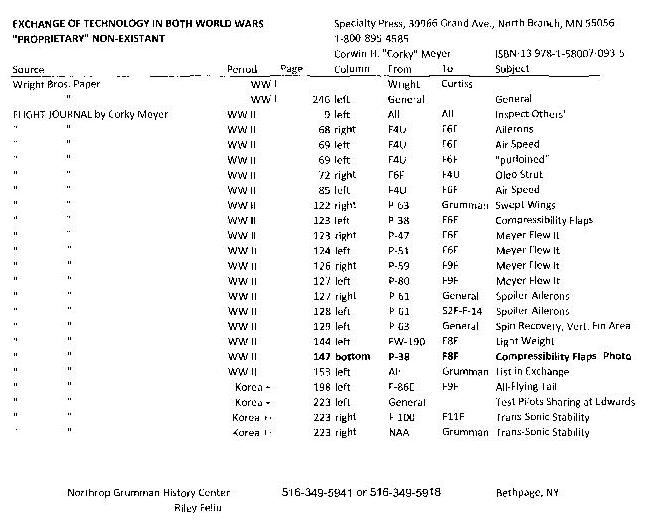
I hold, then, that proprietary rights to the contents of drawings were abrogated by the government. Therefore, my position goes, today's companies cannot restrict our access to public property in the form of government-owned drawings. The drawings are the same as photos marked “Official USN Photo” or “Official USAF Photo”. As this layman sees it, the companies today are limited to rights covering the construction of man-carrying examples. We should be able to get copies of the detail drawings.
As final examples of technology getting around, there is a drawing of a elevator hinge part in my F2G set. Please see the (poor quality) drawing of the part from a Vought drawing (pictured above). While I was working for the Museum of Flight as an assistant lead aircraft restorer at Paine Field, I found this identical part in the elevator trim tab on a De Havilland Comet 4C airliner. See the photos of the hinge fitting on the Comet tab (below).

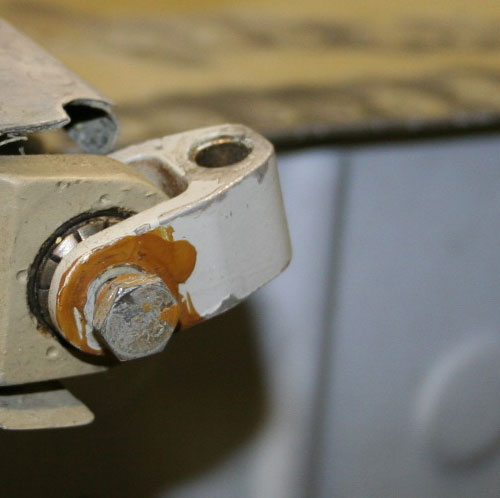
I took pictures of it which are included with this work. The F2G was designed in 1944 and the Comet was designed in England in 1946. Detail parts are common across the manufacturers and are ubiquitous. There is no protection for “proprietary” design details, such that modelers can use in their designs of these airplanes. How you actuate a trim tab cannot be patented, and any such from those times have long-since expired. Also on one of my F2G drawings, a Vought-Sikorsky drawing originally, I found one that states, “This part appears on a Grumman drawing with a different part number.”. Shazam!
This will be my case, then. I plan on requesting the AMA's lawyer review my position later this fall or winter and tell me if it has legal strength. All of AMA's Scale fraternity needs to have access restored, so there is reason for AMA to consider my request for an assessment. It turns out. Further, that there is a law which states that if a person sues the Government, the Government has to cover the cost of the trial. Now, that is an enabling windfall!
I hate to say it but 90%+of the available three-views are garbage. That will be the subject of a subsequent article, though. This one is long enough. Even widely known sources have significant flaws.
This page was upated Nov. 22, 2014